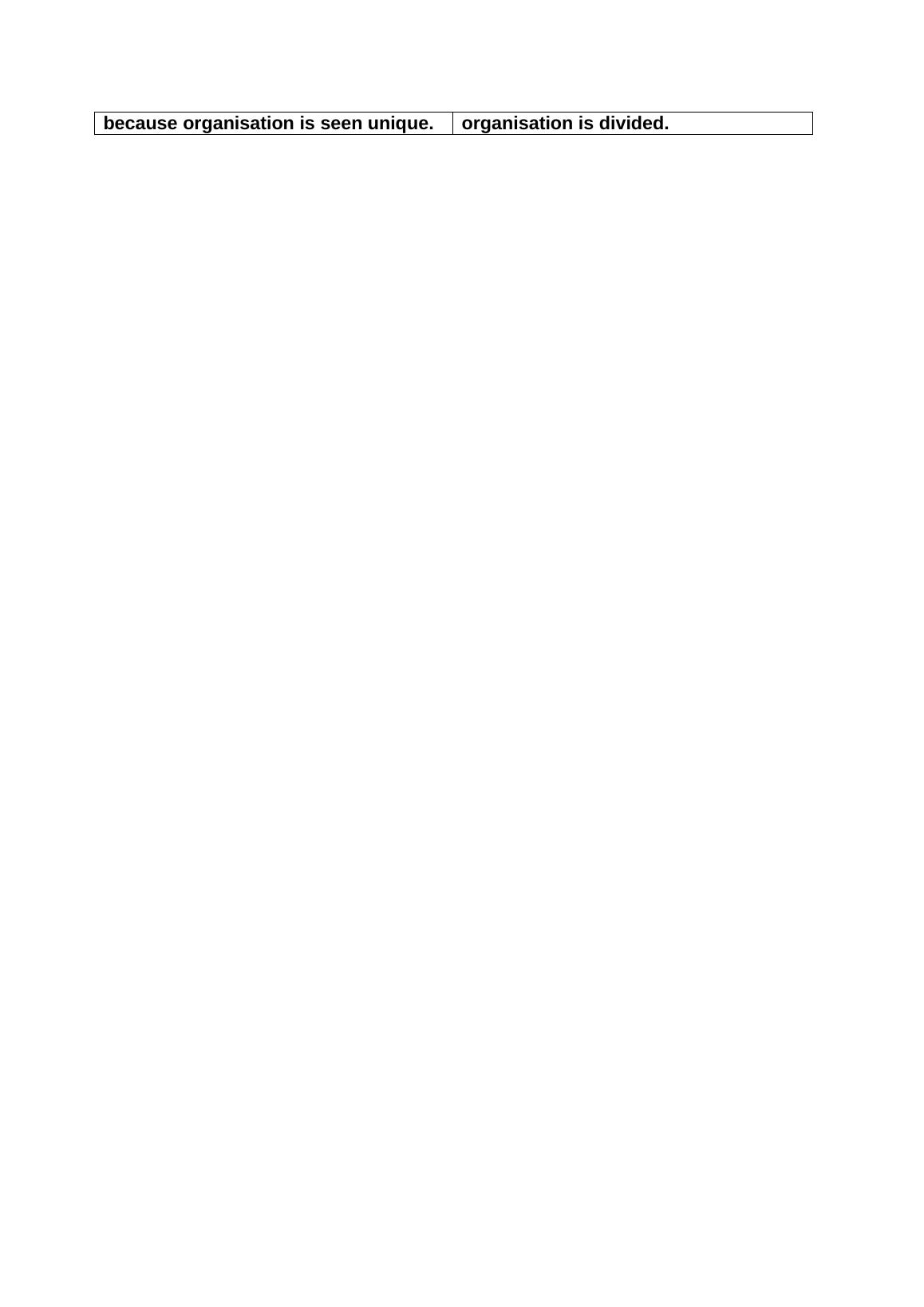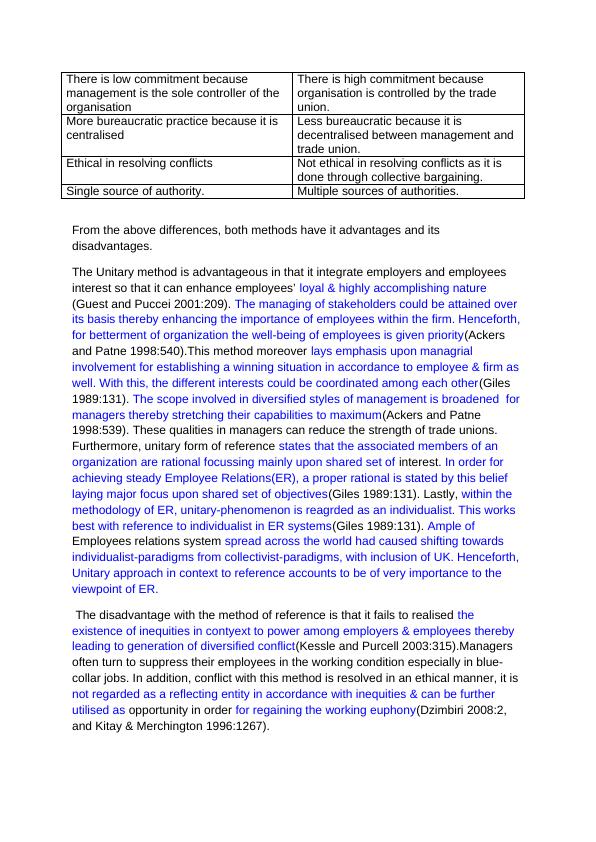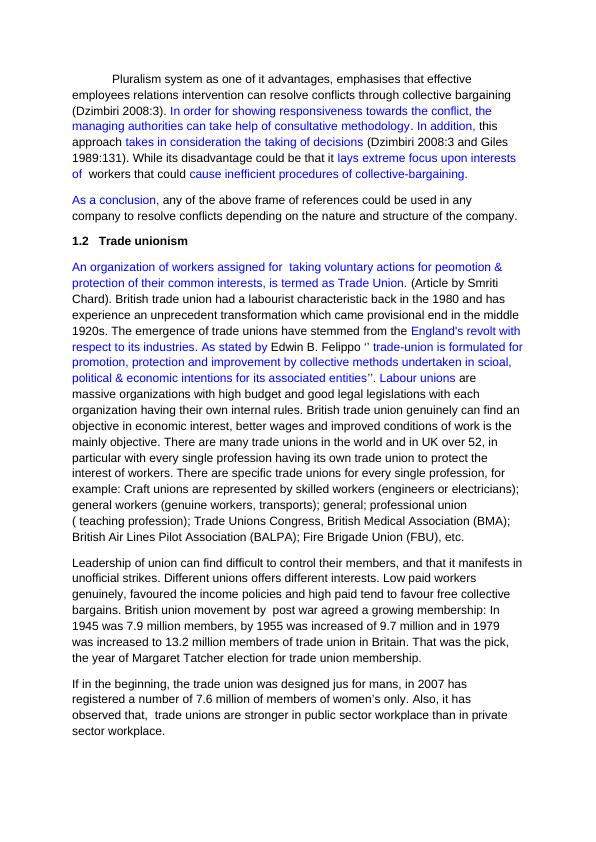Employee Relations Manager : Report
12 Pages4761 Words40 Views
Added on 2020-01-23
Employee Relations Manager : Report
Added on 2020-01-23
ShareRelated Documents
EMPLOYEEE RELATIONS
1.1 Unitary references framework and pluralistic explaination regarding every
perspective implication for proper means in order to ensure conflict resolving
An observable paradigm-shift has been encountered in effective management of
employee-relations(ER) towards the strategic & integrated frame based upon
employees commitments. Furthermore, sharing of interest in terms of workarea is
done rather than traditionally controlling at management level along with conflict
arising between employers & employees. This has beeen occuring since the
1980's(Cully et al.1999:57; Kaufman 2008:317). Namely 3 kinds of Employee
relation perspective namely the unitary, pluralistic and the Neo-Unitary (Farnham
1993:37), however, only two of these methods of ER will be explained in this essay;
the unitary and the pluralistic method. Furthermore, the essay shall exemplify which
method is best for managing successful ER in a company.
Unitary frame of reference refers to one perception towards a particular objective. By
perception here we are referring to the inner thoughts or what you are thinking inside
you and are expressed by your behaviour with the aim of meeting your objective. In
an organisation, unitary frame of reference will mean your personal perception
(presumptions, outlook, moral-code and implementation) in relation with
commitment of organization & management towards its objective. Thus, with
this perspective, for success to be achieved by any given organisation irrespective of
their different roles and job descriptions members must share a similar frame of
mind and have common interest towards organizational targets. Employees are
regarded as loyal. In addition, management's privelage is considered to be guided by
parental-way. Interests of every entity is given the preference. Also management is
the sole focus or loyalty. This method explains, only one higher-authority exists
within a firm to manage and control employees’ relations.
Pluralistic frame of reference refers to a situation whereby the organisation is
formed into powerful & diversified subdivisionspossessing a different set of loyalty in
legal-terms in addition to their self objective and leaders as well. The viewpoint in
terms with pluralistic, comprise of mainly the management of the organisation and
trade unions. In this frame of reference, trade unions act as legal body to workers
and conflict is dealt by collective bargaining. The role of management of enforcing
and controlling workers will be less because most of the decisions will stem from the
trade unions. Focus of management will be to influence and to co-ordinate for the
success of the organisation.
Differences between these two forms of references are seen in the table below:
Unitary System Pluralism System
Organised form of deliberation Deliberation is not organised because
1.1 Unitary references framework and pluralistic explaination regarding every
perspective implication for proper means in order to ensure conflict resolving
An observable paradigm-shift has been encountered in effective management of
employee-relations(ER) towards the strategic & integrated frame based upon
employees commitments. Furthermore, sharing of interest in terms of workarea is
done rather than traditionally controlling at management level along with conflict
arising between employers & employees. This has beeen occuring since the
1980's(Cully et al.1999:57; Kaufman 2008:317). Namely 3 kinds of Employee
relation perspective namely the unitary, pluralistic and the Neo-Unitary (Farnham
1993:37), however, only two of these methods of ER will be explained in this essay;
the unitary and the pluralistic method. Furthermore, the essay shall exemplify which
method is best for managing successful ER in a company.
Unitary frame of reference refers to one perception towards a particular objective. By
perception here we are referring to the inner thoughts or what you are thinking inside
you and are expressed by your behaviour with the aim of meeting your objective. In
an organisation, unitary frame of reference will mean your personal perception
(presumptions, outlook, moral-code and implementation) in relation with
commitment of organization & management towards its objective. Thus, with
this perspective, for success to be achieved by any given organisation irrespective of
their different roles and job descriptions members must share a similar frame of
mind and have common interest towards organizational targets. Employees are
regarded as loyal. In addition, management's privelage is considered to be guided by
parental-way. Interests of every entity is given the preference. Also management is
the sole focus or loyalty. This method explains, only one higher-authority exists
within a firm to manage and control employees’ relations.
Pluralistic frame of reference refers to a situation whereby the organisation is
formed into powerful & diversified subdivisionspossessing a different set of loyalty in
legal-terms in addition to their self objective and leaders as well. The viewpoint in
terms with pluralistic, comprise of mainly the management of the organisation and
trade unions. In this frame of reference, trade unions act as legal body to workers
and conflict is dealt by collective bargaining. The role of management of enforcing
and controlling workers will be less because most of the decisions will stem from the
trade unions. Focus of management will be to influence and to co-ordinate for the
success of the organisation.
Differences between these two forms of references are seen in the table below:
Unitary System Pluralism System
Organised form of deliberation Deliberation is not organised because

because organisation is seen unique. organisation is divided.

There is low commitment because
management is the sole controller of the
organisation
There is high commitment because
organisation is controlled by the trade
union.
More bureaucratic practice because it is
centralised
Less bureaucratic because it is
decentralised between management and
trade union.
Ethical in resolving conflicts Not ethical in resolving conflicts as it is
done through collective bargaining.
Single source of authority. Multiple sources of authorities.
From the above differences, both methods have it advantages and its
disadvantages.
The Unitary method is advantageous in that it integrate employers and employees
interest so that it can enhance employees’ loyal & highly accomplishing nature
(Guest and Puccei 2001:209). The managing of stakeholders could be attained over
its basis thereby enhancing the importance of employees within the firm. Henceforth,
for betterment of organization the well-being of employees is given priority(Ackers
and Patne 1998:540).This method moreover lays emphasis upon managrial
involvement for establishing a winning situation in accordance to employee & firm as
well. With this, the different interests could be coordinated among each other(Giles
1989:131). The scope involved in diversified styles of management is broadened for
managers thereby stretching their capabilities to maximum(Ackers and Patne
1998:539). These qualities in managers can reduce the strength of trade unions.
Furthermore, unitary form of reference states that the associated members of an
organization are rational focussing mainly upon shared set of interest. In order for
achieving steady Employee Relations(ER), a proper rational is stated by this belief
laying major focus upon shared set of objectives(Giles 1989:131). Lastly, within the
methodology of ER, unitary-phenomenon is reagrded as an individualist. This works
best with reference to individualist in ER systems(Giles 1989:131). Ample of
Employees relations system spread across the world had caused shifting towards
individualist-paradigms from collectivist-paradigms, with inclusion of UK. Henceforth,
Unitary approach in context to reference accounts to be of very importance to the
viewpoint of ER.
The disadvantage with the method of reference is that it fails to realised the
existence of inequities in contyext to power among employers & employees thereby
leading to generation of diversified conflict(Kessle and Purcell 2003:315).Managers
often turn to suppress their employees in the working condition especially in blue-
collar jobs. In addition, conflict with this method is resolved in an ethical manner, it is
not regarded as a reflecting entity in accordance with inequities & can be further
utilised as opportunity in order for regaining the working euphony(Dzimbiri 2008:2,
and Kitay & Merchington 1996:1267).
management is the sole controller of the
organisation
There is high commitment because
organisation is controlled by the trade
union.
More bureaucratic practice because it is
centralised
Less bureaucratic because it is
decentralised between management and
trade union.
Ethical in resolving conflicts Not ethical in resolving conflicts as it is
done through collective bargaining.
Single source of authority. Multiple sources of authorities.
From the above differences, both methods have it advantages and its
disadvantages.
The Unitary method is advantageous in that it integrate employers and employees
interest so that it can enhance employees’ loyal & highly accomplishing nature
(Guest and Puccei 2001:209). The managing of stakeholders could be attained over
its basis thereby enhancing the importance of employees within the firm. Henceforth,
for betterment of organization the well-being of employees is given priority(Ackers
and Patne 1998:540).This method moreover lays emphasis upon managrial
involvement for establishing a winning situation in accordance to employee & firm as
well. With this, the different interests could be coordinated among each other(Giles
1989:131). The scope involved in diversified styles of management is broadened for
managers thereby stretching their capabilities to maximum(Ackers and Patne
1998:539). These qualities in managers can reduce the strength of trade unions.
Furthermore, unitary form of reference states that the associated members of an
organization are rational focussing mainly upon shared set of interest. In order for
achieving steady Employee Relations(ER), a proper rational is stated by this belief
laying major focus upon shared set of objectives(Giles 1989:131). Lastly, within the
methodology of ER, unitary-phenomenon is reagrded as an individualist. This works
best with reference to individualist in ER systems(Giles 1989:131). Ample of
Employees relations system spread across the world had caused shifting towards
individualist-paradigms from collectivist-paradigms, with inclusion of UK. Henceforth,
Unitary approach in context to reference accounts to be of very importance to the
viewpoint of ER.
The disadvantage with the method of reference is that it fails to realised the
existence of inequities in contyext to power among employers & employees thereby
leading to generation of diversified conflict(Kessle and Purcell 2003:315).Managers
often turn to suppress their employees in the working condition especially in blue-
collar jobs. In addition, conflict with this method is resolved in an ethical manner, it is
not regarded as a reflecting entity in accordance with inequities & can be further
utilised as opportunity in order for regaining the working euphony(Dzimbiri 2008:2,
and Kitay & Merchington 1996:1267).

Pluralism system as one of it advantages, emphasises that effective
employees relations intervention can resolve conflicts through collective bargaining
(Dzimbiri 2008:3). In order for showing responsiveness towards the conflict, the
managing authorities can take help of consultative methodology. In addition, this
approach takes in consideration the taking of decisions (Dzimbiri 2008:3 and Giles
1989:131). While its disadvantage could be that it lays extreme focus upon interests
of workers that could cause inefficient procedures of collective-bargaining.
As a conclusion, any of the above frame of references could be used in any
company to resolve conflicts depending on the nature and structure of the company.
1.2 Trade unionism
An organization of workers assigned for taking voluntary actions for peomotion &
protection of their common interests, is termed as Trade Union. (Article by Smriti
Chard). British trade union had a labourist characteristic back in the 1980 and has
experience an unprecedent transformation which came provisional end in the middle
1920s. The emergence of trade unions have stemmed from the England's revolt with
respect to its industries. As stated by Edwin B. Felippo ‘’ trade-union is formulated for
promotion, protection and improvement by collective methods undertaken in scioal,
political & economic intentions for its associated entities’’. Labour unions are
massive organizations with high budget and good legal legislations with each
organization having their own internal rules. British trade union genuinely can find an
objective in economic interest, better wages and improved conditions of work is the
mainly objective. There are many trade unions in the world and in UK over 52, in
particular with every single profession having its own trade union to protect the
interest of workers. There are specific trade unions for every single profession, for
example: Craft unions are represented by skilled workers (engineers or electricians);
general workers (genuine workers, transports); general; professional union
( teaching profession); Trade Unions Congress, British Medical Association (BMA);
British Air Lines Pilot Association (BALPA); Fire Brigade Union (FBU), etc.
Leadership of union can find difficult to control their members, and that it manifests in
unofficial strikes. Different unions offers different interests. Low paid workers
genuinely, favoured the income policies and high paid tend to favour free collective
bargains. British union movement by post war agreed a growing membership: In
1945 was 7.9 million members, by 1955 was increased of 9.7 million and in 1979
was increased to 13.2 million members of trade union in Britain. That was the pick,
the year of Margaret Tatcher election for trade union membership.
If in the beginning, the trade union was designed jus for mans, in 2007 has
registered a number of 7.6 million of members of women’s only. Also, it has
observed that, trade unions are stronger in public sector workplace than in private
sector workplace.
employees relations intervention can resolve conflicts through collective bargaining
(Dzimbiri 2008:3). In order for showing responsiveness towards the conflict, the
managing authorities can take help of consultative methodology. In addition, this
approach takes in consideration the taking of decisions (Dzimbiri 2008:3 and Giles
1989:131). While its disadvantage could be that it lays extreme focus upon interests
of workers that could cause inefficient procedures of collective-bargaining.
As a conclusion, any of the above frame of references could be used in any
company to resolve conflicts depending on the nature and structure of the company.
1.2 Trade unionism
An organization of workers assigned for taking voluntary actions for peomotion &
protection of their common interests, is termed as Trade Union. (Article by Smriti
Chard). British trade union had a labourist characteristic back in the 1980 and has
experience an unprecedent transformation which came provisional end in the middle
1920s. The emergence of trade unions have stemmed from the England's revolt with
respect to its industries. As stated by Edwin B. Felippo ‘’ trade-union is formulated for
promotion, protection and improvement by collective methods undertaken in scioal,
political & economic intentions for its associated entities’’. Labour unions are
massive organizations with high budget and good legal legislations with each
organization having their own internal rules. British trade union genuinely can find an
objective in economic interest, better wages and improved conditions of work is the
mainly objective. There are many trade unions in the world and in UK over 52, in
particular with every single profession having its own trade union to protect the
interest of workers. There are specific trade unions for every single profession, for
example: Craft unions are represented by skilled workers (engineers or electricians);
general workers (genuine workers, transports); general; professional union
( teaching profession); Trade Unions Congress, British Medical Association (BMA);
British Air Lines Pilot Association (BALPA); Fire Brigade Union (FBU), etc.
Leadership of union can find difficult to control their members, and that it manifests in
unofficial strikes. Different unions offers different interests. Low paid workers
genuinely, favoured the income policies and high paid tend to favour free collective
bargains. British union movement by post war agreed a growing membership: In
1945 was 7.9 million members, by 1955 was increased of 9.7 million and in 1979
was increased to 13.2 million members of trade union in Britain. That was the pick,
the year of Margaret Tatcher election for trade union membership.
If in the beginning, the trade union was designed jus for mans, in 2007 has
registered a number of 7.6 million of members of women’s only. Also, it has
observed that, trade unions are stronger in public sector workplace than in private
sector workplace.

End of preview
Want to access all the pages? Upload your documents or become a member.
Related Documents
Employee Relations in British Airways : Reportlg...
|14
|4979
|30
Employee Relations in Conflict Situationslg...
|15
|5317
|95
Employee Relations - Unitary and Pluralistic Frameslg...
|23
|4223
|86
Understanding Employment Relationshiplg...
|15
|4799
|164
Employee Relations Assignment | HRM Assignmentlg...
|15
|5126
|35
Employee Relations Assignment | Explain Unitary and Pluralistic Frameslg...
|13
|4616
|235
